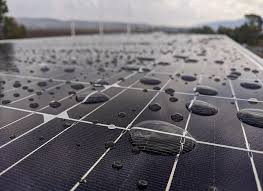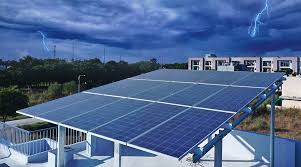Do Solar Panels Work on Cloudy Days?



Do Solar Panels Work on Cloudy Days?
If you’re thinking about going solar in Hyderabad, Vijayawada, or anywhere in Telangana and Andhra Pradesh, you’ve probably wondered: “Will my solar panels still work when it’s cloudy or rainy?” It’s a question we hear all the time at Unilux Solar, and the answer is a big yes—solar panels absolutely generate power even on overcast days.
While they love bright sunshine, modern panels can still pull in enough light to keep your home humming, even during the monsoon season in Visakhapatnam or a cloudy day in Warangal. Let’s break down how it works, why it matters for our region, and how to make the most of your solar setup, no matter the weather.
How Solar Panels Work (Sunny or Not)
Solar panels use photovoltaic (PV) cells, usually made of silicon, to turn sunlight into electricity. When sunlight hits the panel, it energizes electrons in the cells, creating a direct current (DC). An inverter then converts this into alternating current (AC) to power your fridge, AC, or TV.
On clear days, panels soak up direct sunlight for max output. But on cloudy days, they capture diffuse light—scattered sunlight that sneaks through clouds. It’s less intense, but it still gets the job done, producing 25–50% of typical output in Telangana or AP’s cloudy conditions.
Cloudy Days in Telangana & AP: What to Expect
Our region gets plenty of sun, but monsoons and overcast skies are part of life, especially in coastal areas like Vijayawada or humid spots like Guntur. Here’s how clouds affect your panels:
- Light Clouds: Thin, high clouds let through more diffuse light, so panels might only dip by 10–20% efficiency. You’ll barely notice a difference in Hyderabad’s lighter overcast days.
- Heavy Clouds: Thick storm clouds (common in AP’s coastal monsoons) can cut output to 25–50% of normal. Still, that’s enough to power essentials in a Secunderabad home.
- Monsoon Season: July–September brings rain, but panels keep working. In fact, rain can clean dust off panels, boosting efficiency in dusty Kurnool.
- Winter Days: Shorter daylight in Telangana’s winter reduces output slightly, but clear days are common, keeping your system productive.
Modern panels, like monocrystalline or mono-PERC half-cut bifacial, are built for low-light performance, making them perfect for our region’s mix of sun and clouds.
Key Factors Affecting Cloudy-Day Performance
Several things influence how much power your panels produce when skies are grey:
- Cloud Thickness: Thin clouds in Warangal let through more light than dense monsoon clouds in Visakhapatnam, impacting output (10% vs. 50% reduction).
- Season: Longer summer days in Hyderabad give panels more time to generate, even if cloudy. Winter’s shorter days mean clouds hit harder, but clear skies balance it out.
- Location: Telangana and AP are solar goldmines—near the equator, we get strong sunlight year-round. Even cloudy days in Vijayawada produce decent power compared to northern hill states.
- Local Weather: Coastal AP sees more humid, overcast days, while inland Telangana (like Secunderabad) gets clearer skies. Panels still perform, but output varies.
Is Solar Worth It in Cloudy Telangana & AP?
Absolutely! With the right setup, solar thrives even in our monsoon-heavy or occasionally cloudy climate. Here’s why:
- Year-Round Sun: Telangana and AP average 300+ sunny days, so clouds are a minor hiccup.
- Tech Advantage: High-efficiency panels and smart inverters squeeze more power from diffuse light.
- Subsidies: PM Surya Ghar offers up to ₹78,000 off, making solar affordable for Hyderabad or Guntur homes.
- Savings: A 3 kW system (~₹1.32 lakh post-subsidy) can save ~₹16–17 lakh over 25 years, even factoring in cloudy days.
Tips to Max Out Solar on Cloudy Days
To keep your system humming in Telangana’s monsoons or AP’s coastal haze, try these:
- Optimize Tilt & Orientation: South-facing panels with a 12–15° tilt (ideal for our latitude) capture max diffuse light. North-facing panels can grab extra scattered light on cloudy days.
- Pick High-Efficiency Panels: Mono-PERC half-cut bifacial panels (22–22.5% efficiency) outperform standard ones in low light—Unilux’s go-to for Warangal’s haze.
- Use Smart Inverters: MPPT inverters adjust to variable light, boosting output in Visakhapatnam’s cloudy spells.
- Keep Panels Clean: Monsoon rains help, but regular cleaning in dusty Kurnool ensures no dirt blocks light.
- Work with Pros: Unilux Solar designs systems tailored to your roof, local weather, and energy needs.
Busting Cloudy-Day Solar Myths
Let’s clear up some misconceptions floating around:
- Myth 1: Panels don’t work on cloudy days.
Fact: They generate 25–50% of normal output using diffuse light. Places like Germany thrive on solar despite clouds—Telangana and AP are even better suited. - Myth 2: Solar only works in super sunny spots.
Fact: Our region’s 300+ sunny days and strong diffuse light make solar a no-brainer. Even coastal Vizag gets enough light for solid returns.
Fun Fact: Ladakh’s 320+ sunny days and cool temps make it India’s solar champ, but Telangana and AP’s year-round sun and fewer temperature swings are close contenders.
Why Go with Unilux Solar?
Unilux Solar makes your journey from high bills to free power a breeze in Telangana and Andhra Pradesh. With a 4.8 Google rating from thousands of happy customers, here’s what sets us apart:
- Guaranteed Output: If your system underperforms, we pay ₹8/unit for the shortfall.
- Storm-Ready: WindPro Mount™ (IIT-Bombay approved) handles 170 kmph winds—perfect for AP’s coastal storms.
- Leak-Proof: HILTI anchoring + ₹1 lakh no-leak guarantee for year one.
- Top Care: 45+ maintenance visits over 5 years keep panels spotless and efficient.
- Tailored Design: We factor in your roof, local clouds, and energy needs for max output.
Our 545W mono-PERC half-cut bifacial panels deliver more power in less space, ideal for Hyderabad’s compact roofs or Vijayawada’s open terraces.
Wrapping Up
Solar panels work like champs on cloudy days in Telangana and Andhra Pradesh, producing 25–50% of their usual output thanks to diffuse light. With high-efficiency panels, smart inverters, and Unilux Solar’s custom designs, you’ll save a lot—think ₹34–35 lakh over 25 years for a 5 kW system—even with our region’s monsoons. The PM Surya Ghar subsidy (up to ₹78,000) sweetens the deal, but it won’t last forever. Book a free consultation with Unilux Solar today and start powering your home, rain or shine!
FAQs
Q1. How much power do panels produce on cloudy days?
A::They generate 25–50% of normal output (10–25% in heavy clouds, 50–80% in light clouds), depending on cloud thickness and location. High-efficiency panels (like Unilux’s) boost this.
Q2. How efficient are panels on cloudy days?
A: About 50–80% less than sunny days, dropping to 10–25% in thick clouds, per NREL data. No output at night, but Telangana/AP’s bright days keep overall production strong.
Q3. How does weather affect solar?
A: Clouds, rain, or dust cut output, but cool temps (common in coastal AP) can boost panel efficiency. Regular cleaning helps in dusty Warangal.
Q4. How to boost solar on cloudy days?
A: Use high-efficiency panels, MPPT inverters, south-facing 12–15° tilt, and keep panels clean. Unilux Solar’s designs maximize output for Telangana/AP’s weather.


